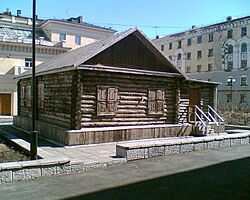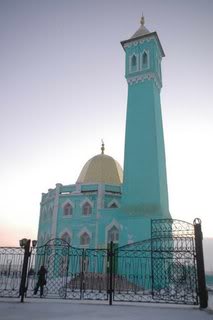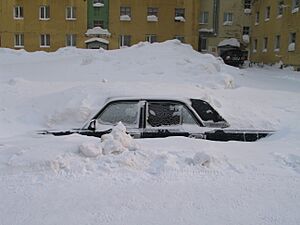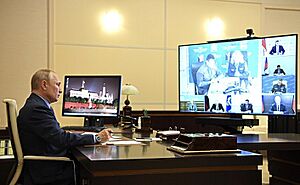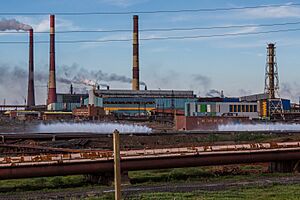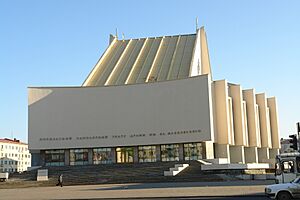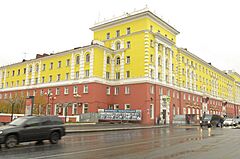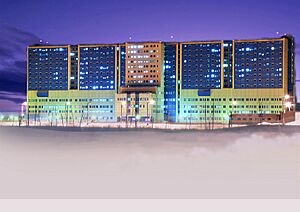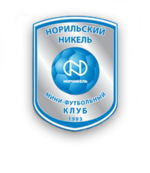Norilsk facts for kids
Quick facts for kids Norilsk (English)Норильск (Russian) |
|
|---|---|
| - City - | |
 Leninsky Prospekt in central Norilsk (June 2016) |
|
|
|
|
| Administrative status | |
| Country | Russia |
| Federal subject | Krasnoyarsk Krai |
| Administratively subordinated to | district city of Norilsk |
| Municipal status | |
| Urban okrug | Norilsk Urban Okrug |
| Statistics | |
| Area | 23.16 km2 (8.94 sq mi) |
| Population (2010 Census, preliminary) |
175,365 inhabitants |
| - Rank in 2010 | 102nd |
| Population (2024 est.) | 176,735 inhabitants |
| Density | 7,572/km2 (19,611/sq mi) |
| Time zone | KRAT (UTC+08:00) |
| Founded | 1935 |
| City status since | 1953 |
| Postal code(s) | 663300-663341 |
| Dialing code(s) | +7 3919 |
| Official website: http://www.norilsk-city.ru/ | |
Norilsk (Russian: Нори́льск) is a unique closed city in Krasnoyarsk Krai, Russia. It's located far north, about 300 km (186 miles) above the Arctic Circle. This makes it one of the world's northernmost cities with a large population.
Norilsk is special because it sits on huge deposits of valuable metals like nickel, copper, and palladium. Because of this, mining and processing these metals are the main jobs here. The city is also one of the few large cities built on continuous permafrost, which is ground that stays frozen all year round.
The city's population is around 176,735 people as of 2024. If you include temporary workers, it can reach up to 220,000. Norilsk is the second-largest city in its region, after Krasnoyarsk.
Access to Norilsk is limited for people from other countries. Foreign visitors need special permission to enter the city.
Contents
- What's in a Name?
- A Look Back: Norilsk's History
- City Structure
- Who Lives in Norilsk?
- Time Zone
- Norilsk's Location and Weather
- Norilsk's Economy
- Getting Around Norilsk
- Staying Connected
- Learning in Norilsk
- Norilsk's Culture and Arts
- City Buildings and Design
- Media and News
- Healthcare in Norilsk
- Sports and Activities
- Community Projects
- Famous People from Norilsk
- Sister Cities
- Images for kids
- See also
What's in a Name?
Norilsk gets its name from its location. The Norilsk River flows nearby, and the city is close to the Norilsk Mountains. Early explorers like Khariton Laptev and Alexander Fyodorovich Middendorf mentioned these places in their travel stories.
Some people think the name comes from the word norilo. This was a long pole used by Russian fishing people in the 16th-17th centuries. They used it to set up fishing nets under the ice.
Others believe the name might come from local languages. For example, the Yukagir word nerile means "an earthen hill with cliffs." The Evenk word narus or Yukaghir nioril means "swamps." It could also be from an Evenk tribe called the Nyurilians, or a nearby lake, Lake Murilskoye.
A Look Back: Norilsk's History
People knew about the rich minerals in the Norilsk area a very long time ago, even in the Bronze Age. Ancient people used copper from these deposits. In the 16th and 17th centuries, people from a city called Mangazeya used Norilsk copper.
A geologist and explorer named Nikolay Urvantsev studied the Norilsk region in the 1920s. He confirmed that there were large amounts of coal and other metal ores.
In 1921, Urvantsev's team built a small log cabin. This cabin is thought to be the very first building in Norilsk. Today, it's a historical monument near the Norilsk Museum.
Norilsk was officially founded in 1935. At that time, a system of labor camps called Norillag was set up. Prisoners from these camps were forced to build the Norilsk Mining and Metallurgical Plant. Over time, Norilsk grew from a small settlement to a city in 1953.
In the late 1940s, new parts of the city were designed. Building work started in 1951. In 1953, some prisoners went on strike in what was known as the Norilsk Uprising.
A railway was built to connect Norilsk to the port of Dudinka on the Yenisei River. This railway was important for transporting goods. The Norillag camps were officially closed in 1956. Many people died during the years these camps were active due to hard labor and harsh conditions.

Today, there are several memorials in Norilsk to remember the past. One important memorial is the Norilsk Golgotha. It was built on a hillside where many prisoners were buried.
In 1966, a new and even larger deposit of copper-nickel ores was found. This led to the founding of the mining town of Talnakh. A new large plant, the Nadezhda Metallurgical Plant, was built to process these new materials.
Today, Talnakh is the main place for mining and processing ore. The processed ore is then sent to Norilsk's metal plants. Metals like nickel and copper are shipped from Dudinka to other cities, mainly during the summer when the river is not frozen.
Working in the Norilsk-Talnakh mines can be dangerous. Companies are working to improve safety. In June 2020, a large amount of diesel fuel spilled from a power plant. This caused serious damage to the local environment. Cleanup efforts followed this event.
Norilsk remains a closed city. This means foreign citizens still need special permission to visit.
City Structure
Norilsk is divided into three main areas:
- Tsentralny District (which includes Oganer)
- Talnakh
- Kayerkan
The settlement of Snezhnogorsk is also part of Norilsk's area.
Who Lives in Norilsk?
| Historical population | ||
|---|---|---|
| Year | Pop. | ±% |
| 1939 | 13,886 | — |
| 1959 | 109,442 | +688.1% |
| 1970 | 135,487 | +23.8% |
| 1979 | 180,358 | +33.1% |
| 1989 | 174,673 | −3.2% |
| 2002 | 134,832 | −22.8% |
| 2010 | 175,365 | +30.1% |
| 2021 | 174,453 | −0.5% |
| Source: Censuses | ||
The population of Norilsk was 174,453 in 2021. After the Soviet Union ended, the population dropped. But then, the towns of Kayerkan and Talnakh became part of Norilsk. This helped keep the population around 175,000. Including temporary residents, the total can reach up to 220,000.
Norilsk has a mix of different ethnic groups. Most people living here moved to the city in the second half of the 20th century, or they are descendants of those who moved. Many descendants of former prisoners also live in the city. There are very few people from the original indigenous groups, such as the Nenets or Dolgans.

In 2021, 77 different ethnic groups were recognized in Norilsk. Here's a look at the main groups:
| Ethnicity | Population | Percentage |
|---|---|---|
| Russians | 107,189 | 81.7% |
| Azerbaijanis | 4,694 | 3.6% |
| Ukrainians | 2,683 | 2.0% |
| Tatars | 1,792 | 1.4% |
| Bashkirs | 1,769 | 1.3% |
| Nogais | 1,748 | 1.3% |
| Lezgins | 1,588 | 1.2% |
| Others | 9,806 | 7.5% |
Religion in Norilsk
The main religion in Norilsk is Orthodox Christianity. There are several Orthodox churches and a cathedral. Norilsk also has a mosque, built in 1998. It is believed to be the northernmost Muslim prayer house in the world.
Time Zone
Norilsk uses Krasnoyarsk Time. This means it is seven hours ahead of UTC (Coordinated Universal Time). It is also four hours ahead of Moscow Time.
Norilsk's Location and Weather
Norilsk is located at the base of the Putorana Mountains. It is one of the world's most northern cities. It's the second-largest city built on permafrost (after Yakutsk) and the second-largest city inside the Arctic Circle (after Murmansk).
Norilsk has a very harsh subarctic climate. It's one of the coldest cities in the world. Winters are very long, extremely cold, and dark, lasting from early October to May. Snow covers the ground for seven to nine months, and there are more than 50 days of snowstorms. Strong winds are common. The average temperature in January is about -27°C (-17°F).
During the summer, from May 20 to July 24, Norilsk experiences the midnight sun. This means the sun stays above the horizon all day and night. In contrast, the polar night lasts from about November 30 to January 13. During this time, the sun does not rise at all.
Summers are short and cool, usually in mid-July. The average temperature in July is about 14-15°C (58°F). However, temperatures can sometimes go above 25°C (77°F).
The average yearly temperature in Norilsk is -9.6°C (14.7°F).
| Climate data for Norilsk | |||||||||||||
|---|---|---|---|---|---|---|---|---|---|---|---|---|---|
| Month | Jan | Feb | Mar | Apr | May | Jun | Jul | Aug | Sep | Oct | Nov | Dec | Year |
| Record high °C (°F) | −0.6 (30.9) |
−0.6 (30.9) |
7.4 (45.3) |
14.0 (57.2) |
23.0 (73.4) |
32.0 (89.6) |
32.0 (89.6) |
30.2 (86.4) |
24.5 (76.1) |
16.1 (61.0) |
2.8 (37.0) |
−0.4 (31.3) |
32.0 (89.6) |
| Mean daily maximum °C (°F) | −23.6 (−10.5) |
−23.9 (−11.0) |
−18.4 (−1.1) |
−10.0 (14.0) |
−1.7 (28.9) |
10.4 (50.7) |
18.2 (64.8) |
15.0 (59.0) |
6.9 (44.4) |
−6.7 (19.9) |
−16.9 (1.6) |
−21.6 (−6.9) |
−6.0 (21.2) |
| Daily mean °C (°F) | −26.9 (−16.4) |
−27.2 (−17.0) |
−21.9 (−7.4) |
−13.9 (7.0) |
−4.8 (23.4) |
7.0 (44.6) |
14.3 (57.7) |
11.4 (52.5) |
4.0 (39.2) |
−9.5 (14.9) |
−20.2 (−4.4) |
−25.1 (−13.2) |
−9.6 (14.7) |
| Mean daily minimum °C (°F) | −30.7 (−23.3) |
−31.0 (−23.8) |
−26.4 (−15.5) |
−18.5 (−1.3) |
−8.4 (16.9) |
3.2 (37.8) |
10.0 (50.0) |
7.6 (45.7) |
1.2 (34.2) |
−12.5 (9.5) |
−23.9 (−11.0) |
−28.9 (−20.0) |
−13.4 (7.9) |
| Record low °C (°F) | −53.1 (−63.6) |
−52.0 (−61.6) |
−48.0 (−54.4) |
−38.7 (−37.7) |
−26.8 (−16.2) |
−9.8 (14.4) |
0.4 (32.7) |
−1.7 (28.9) |
−13.0 (8.6) |
−36.0 (−32.8) |
−48.9 (−56.0) |
−51.0 (−59.8) |
−53.1 (−63.6) |
| Average precipitation mm (inches) | 17.6 (0.69) |
16.1 (0.63) |
28.4 (1.12) |
21.1 (0.83) |
24 (0.9) |
34.4 (1.35) |
32.4 (1.28) |
52.2 (2.06) |
26 (1.0) |
35.9 (1.41) |
30.8 (1.21) |
22.1 (0.87) |
341 (13.4) |
| Average precipitation days | 11.7 | 10.9 | 14.0 | 13.9 | 15.7 | 14.0 | 13.4 | 15.9 | 16.3 | 18.5 | 13.7 | 13.6 | 171.6 |
| Mean daily sunshine hours | 0 | 1 | 5 | 8 | 8 | 8 | 10 | 6 | 3 | 2 | 0 | 0 | 4 |
| Average ultraviolet index | 0 | 0 | 1 | 2 | 3 | 3 | 4 | 3 | 1 | 0 | 0 | 0 | 1 |
| Source: Weatherbase MeteoBlue Weather Atlas OGMIET | |||||||||||||
Norilsk's Rich Mineral Deposits
The Norilsk-Talnakh area has the world's largest known deposits of nickel, copper, and palladium. These minerals formed about 250 million years ago. This happened during a huge volcanic event that covered a vast area with lava.
Norilsk is a major center for processing non-ferrous metals. The mining company Norilsk Nickel operates here. They mine nickel, copper, and cobalt. They also find precious metals like palladium, platinum, gold, and silver.
Protecting the Environment
Norilsk has faced serious environmental challenges, especially with air pollution. The smelting of nickel ore has caused acid rain and smog. Some estimates suggest that Norilsk's nickel mines produce one percent of the world's sulfur dioxide emissions.
The Blacksmith Institute once listed Norilsk among the 10 most polluted places on Earth. This was due to air pollution from metals and gases.
However, Norilsk Nickel has started many projects to reduce pollution. In 2016, they closed an old nickel plant. This helped cut annual pollutant emissions by about 400,000 tons.
The company has invested billions of rubles in a "Sulfur Project." This project aims to reduce sulfur dioxide emissions by 75% by 2023. It involves modernizing plants and moving some production outside the city.
In 2021, the "Clean Norilsk" project began. Its goal is to remove old, abandoned buildings and industrial waste. This project is part of a bigger national environmental program called "Clean Arctic."
The 2020 Diesel Spill
On May 29, 2020, a large amount of diesel fuel spilled from a power plant. About 21,000 tons of fuel leaked into the ground and nearby rivers. This was one of the biggest oil spills in Russian history.
The spill caused serious damage to the local ecosystem. The Russian president declared a state of emergency. Cleaning up the area was difficult because there were no roads, and the river was too shallow for boats.
Norilsk Nickel was ordered to pay a large fine for the spill. Cleanup work was announced as complete in August 2021.
Water Supply
Norilsk has many water treatment facilities. These facilities are always being updated to make sure the city has clean water. Norilsk Nickel helps fund these improvements.
Norilsk's Economy
MMC Norilsk Nickel is the main employer in Norilsk. This mining company is a huge player in the world. They produce:
- 35% of the world's palladium
- 25% of its platinum
- 20% of its nickel
- 20% of its rhodium
- 10% of its cobalt
In Russia, Norilsk Nickel produces almost all of the country's nickel and cobalt. The company also produces a lot of copper.
The Norilsk area has all the necessary facilities for metal production. This includes power plants, construction companies, and repair services. The city's power comes from three combined cycle power plants owned by Norilsk Nickel.
Getting Around Norilsk
Norilsk has its own airport, Alykel Airport, located 35 kilometers (22 miles) west of the city. The airport has been modernized to handle more flights and improve safety.
The Norilsk railway connects Norilsk to the port of Dudinka. However, this railway is only used for freight, not for passengers, since 1998.
Norilsk is not connected to the rest of Russia by road or rail. This means Norilsk and Dudinka are like an island. Goods are transported to and from Norilsk by boat on the Arctic Ocean or the Yenisei River. This usually happens during the summer when the waterways are not frozen.
Within the city, Norilsk has a bus network and many taxi companies. During bad weather, special off-road vehicles transport workers to industrial sites outside the city.
Staying Connected
Norilsk has a modern telephone network. Several companies provide fixed-line phone services.
Cellular communication started later in Norilsk, in 2001. Now, there are four major mobile operators in the city. They offer both 3G and other services.
Since 2017, Norilsk has had high-speed internet access through a fiber optic cable. Before this, internet was much slower and only available via satellite. The fiber optic line was a big project, costing billions of rubles. It greatly improved internet speeds, making them 40 times faster.
In 2019, the city switched to digital television.
Learning in Norilsk
Norilsk has several places for higher education, including:
- Fedorovsky Polar State University
- Zabaikalsky State University Polytechnic College
- Norilsk College of Arts
- Norilsk Pedagogical College
- Norilsk Medical College
- Norilsk College of Industrial Technologies and Service
The city also has many schools for younger students. This includes preschools, secondary schools, and special schools like lyceums. There are also places for kids to learn outside of regular school, like centers for young technicians and art schools.
Norilsk's Culture and Arts
Norilsk has a rich cultural scene. It has a museum, an art gallery, and the "First House of Norilsk" museum. The city also has several theaters, cinemas, and music and art schools.
The Norilsk Polar Drama Theater is one of the world's northernmost theaters. It was founded in 1941. Many famous actors performed there, some of whom were prisoners at the time.
The city hosts several big cultural festivals each year. These include the Bolshoi Argish festival and the Land is Our Common Home festival. Norilsk's library system is considered one of the best in its region.
Like other cities built around metal industries, Norilsk celebrates Metallurgist's Day in July. Indigenous people in the area celebrate the Heiro festival. This marks the return of the sun after the long polar night.
Norilsk Nickel plans to build an Arctic Museum of Contemporary Art (AMMA). This will be a large new museum for art.
City Buildings and Design
The design of Norilsk was planned by architects who were prisoners. They designed the first buildings in a classical style, similar to buildings in St. Petersburg.
One challenge was dealing with strong winds and heavy snow. The city's buildings are often designed in compact blocks to help protect against the wind.
An unusual feature of Norilsk is that its gas and water pipes run above ground. This is because the ground, which is permafrost, melts and freezes seasonally. Laying pipes underground would cause problems.
The city center has many buildings in a classical style. The outer areas have taller apartment buildings.
Buildings and Thawing Permafrost
Rising temperatures in the Arctic are causing the permafrost to thaw. This can make building foundations unstable. To fix this, authorities are working on a program to stabilize the foundations of many apartment buildings.
This program uses a system of pipes with a special liquid that helps keep the ground frozen. This helps to protect the buildings.
Media and News
Television
Norilsk has its own television station, Norilsk TV. It broadcasts local news and other programs. Another local channel, "The Northern City of Norilsk," also provides news.
Radio Stations
Norilsk has many radio stations, offering a variety of music and news. Some popular stations include Radio Mayak, Hit FM, Russkoye Radio, and Europa Plus.
Print Publications
The city's main newspaper is Zapolyarnaya Pravda, founded in 1953. It covers daily life, local businesses, and community news. There are also free papers with advertisements.
Healthcare in Norilsk
Norilsk has a full range of public healthcare services. There are clinics for children and adults, emergency rooms, and dentist clinics in all city districts. There is also a children's hospital and a blood center.
Many private healthcare clinics also offer various services. The largest hospital in Norilsk is the general city hospital. New healthcare centers are also being built in the city.
Sports and Activities
Norilsk is proud of its futsal club, MFK Norilsk Nickel. Futsal is a type of indoor soccer. The club has won the Russian championship and the Russian Cup.
The city has many sports facilities. These include:
- The Arktika sports palace
- Swimming pools
- Outdoor stadiums
- Indoor skating rinks
- Skiing centers and resorts
Children and teenagers can choose from many sports like basketball, volleyball, gymnastics, swimming, boxing, hockey, and figure skating.
Curling is also a popular sport. Norilsk hosts an international curling competition called the WCT Arctic Cup.
A new large sports center called Aika opened in 2020.
Community Projects
The Russian government, the Krasnoyarsk Territory, Norilsk, and Norilsk Nickel are working together on projects to develop the city until 2035. These projects include:
- Renovating housing
- Repairing infrastructure
- Helping residents move to areas with better living conditions
Many families have already moved to other parts of Russia through these programs.
Famous People from Norilsk
Many notable people were born in Norilsk, including:
- Vakha Albakov (born 1985), footballer
- Alexander Auzan (born 1954), economist
- Andrey Bartenev (born 1965), artist
- Vladimir Bure (born 1950), swimmer
- Dmitri Torbinski (born 1984), footballer
- Natalia Yurchenko (born 1965), gymnast
Sister Cities
Norilsk is connected with two other cities:
Images for kids
See also
 In Spanish: Norilsk para niños
In Spanish: Norilsk para niños




